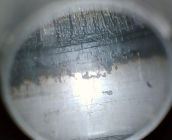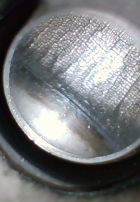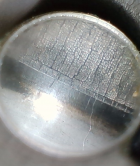You are using an out of date browser. It may not display this or other websites correctly.
You should upgrade or use an alternative browser.
You should upgrade or use an alternative browser.
Carbon removal
- Thread starter TTE
- Start date
hpshooter
Gold $$ Contributor
As soon as I finish my 20 record rounds in our modified F class match I crank my front rest down to have the bore running down hill, put my bore guide in and put a good shot of Wipe Out foam down the bore while it is warm. Rubber band a small baggie over the muzzle, case the rifle and head home. After a few hours will start running a couple patches of Wipe out down the bore and they come out looking like they have been dipped in black paint. Will do several round of patch and soak until bore scope shows no carbon.yea...reloader 15 will amaze you during the cleaning process...LOL
This is in a 6.5x47 Lapua running 123 Scenars and 38.5 grains of RL15.
6BRA
Gold $$ Contributor
Looks like black powder..horrible. agree.As soon as I finish my 20 record rounds in our modified F class match I crank my front rest down to have the bore running down hill, put my bore guide in and put a good shot of Wipe Out foam down the bore while it is warm. Rubber band a small baggie over the muzzle, case the rifle and head home. After a few hours will start running a couple patches of Wipe out down the bore and they come out looking like they have been dipped in black paint. Will do several round of patch and soak until bore scope shows no carbon.
This is in a 6.5x47 Lapua running 123 Scenars and 38.5 grains of RL15.
Mark W
Gold $$ Contributor
Tested tons of stuff. Flitz liquid and a brush gets it all everytime and is my favorite. Patch out works well also.
Same here! When I first got a bore scope, I ordered over $200 in cleaning supplies. Flitz Bore Cleaner (not metal polish) does by far the best job of cleaning the carbon in my barrels.
While playing with my new borescope a few years back, a pretty significant carbon ring was noticed on a rifle that came to me very used & that I've had for 30+ years. Unknown total # of rounds. I have about 1800-2000 pushed hard & fast rounds through it. Been using 2/3 Shooter Choice & 1/3 Kroil all along. Nothing else I own has even close to this amount of buildup. It's an Ackley, so slow growth of the shortened case after fireforming may have something to do with it.

The 1st thing tried was Carb-out, scrubbing & brushing & soaking for 3 or 4 days before giving up.

Rechecked after c.100 rds. & it was gone. Unsure if it burned out from all the soaking or was loosened enough & was blown out, but it's gone.

Time for a new barrel?

The 1st thing tried was Carb-out, scrubbing & brushing & soaking for 3 or 4 days before giving up.

Rechecked after c.100 rds. & it was gone. Unsure if it burned out from all the soaking or was loosened enough & was blown out, but it's gone.

Time for a new barrel?
I don't rapid fie my barrels anymore. Shot one out really quick doing that. In the .223, I'm using AA2015, and a rather warm load of it which I'm sure doesn't help. I clean my rifles after every session, and that's mostly 50rds or less for each one.Wow, that's something I've never experienced but that certainly sound like a good reason.
I'm interested in learning more - what do you think caused it? Lots or rapid-fire shooting? Long periods between cleaning cycles? The reason I ask is that I have several varmint bolt rifles, 223 Rem's with over 2,000 to 3000 round though them and I haven't experienced that yet.
I use to clean about every 30 to 40 rounds but have extended it to 40-60 rounds. I used Shooter's Choice with a bronze brush for many, many years until about 2 years ago when I switched to Bore Tech C4, only to avoid the offensive odor of Shooter's Choice.
What size patches are you using? In .223 I use 1 1/4 or 1 3/8ths square patches. If your using a 1 inch square, or even worse a round one, then you likely won't feel the bore tightening up. As an example, I cleaned my new {to me} 6PPC that only had 40 rounds through it, and JB wouldn't get that much carbon out without a lot more work, so I used IOSSO. At the start, a 1 3/8ths patch had to be stabbed off center just to get started. When I was done, I was able to use a 1 3/4 square patch. That's a world of difference in patch sizes on a bore that small.
Is that the stuff that smells like band-aids & makes the hair on your arm stand up if there's any contact?You have just opened a can of worms once again!...
But to answer your question,...yes many of us have with good to Average results.
But no matter how many people state DONT USE BRONZE BRUSHES..
YOU" need them.
This has been the very best for me...25 year tested.
I used Pro Shot patches, cotton flannel. In my 223 Rem's I use a 1 1/8 size patch with a Dewey jag. To obtain optimum fit, I had to reduce the jag diameter a few thousands.I don't rapid fie my barrels anymore. Shot one out really quick doing that. In the .223, I'm using AA2015, and a rather warm load of it which I'm sure doesn't help. I clean my rifles after every session, and that's mostly 50rds or less for each one.
What size patches are you using? In .223 I use 1 1/4 or 1 3/8ths square patches. If your using a 1 inch square, or even worse a round one, then you likely won't feel the bore tightening up. As an example, I cleaned my new {to me} 6PPC that only had 40 rounds through it, and JB wouldn't get that much carbon out without a lot more work, so I used IOSSO. At the start, a 1 3/8ths patch had to be stabbed off center just to get started. When I was done, I was able to use a 1 3/4 square patch. That's a world of difference in patch sizes on a bore that small.
Optimum fit being defined as a tight fit but not so tight that the rod has be forced down the bore.
I suspect your difficulty in feeding a patch down the bore is not due to carbon build up especially if you're cleaning every 50 rounds but rather due to matching the jag diameter to the patches you use to provide optimum fit.
Never had that encounter of third kind!...Is that the stuff that smells like band-aids & makes the hair on your arm stand up if there's any contact?
I'm using the same rod and jag. I don't have any difficulty getting a larger patch down the bore after I clean it.I used Pro Shot patches, cotton flannel. In my 223 Rem's I use a 1 1/8 size patch with a Dewey jag. To obtain optimum fit, I had to reduce the jag diameter a few thousands.
Optimum fit being defined as a tight fit but not so tight that the rod has be forced down the bore.
I suspect your difficulty in feeding a patch down the bore is not due to carbon build up especially if you're cleaning every 50 rounds but rather due to matching the jag diameter to the patches you use to provide optimum fit.
6MMsteve
Gold $$ Contributor
how I do itFirst, follow these instructions on how to set up with patch and Parker Hale jag with JB or USP Bore paste

Cryptocurrency Prices, Market Cap, Trading Charts: Bitcoin, Ethereum and more at PiedPiper
Live cryptocurrency prices, market caps, charts & daily insights for a wide range of coins on PiedPiper. Compare trends, top gainers and trading volume 24/7.docplayer.net
1. Push one patch wet with Kroil Oil through the barrel
2. Repeat step 1.
3. Push one dry patch through the barrel.
4. Repeat step 3.
5. Push one patch wet with Butch's Bore Shine through the barrel.
6. Repeat step 5.
7. Let the barrel soak for 5 to 10 minutes.
8. Push one dry patch through the barrel.
9. Repeat step 8.
10. Using short strokes back and forth push one patch wet with USP or JB Bore Paste through the barrel.
11. Push one patch wet with Kroil through the barrel.
12. Repeat step 11 twice.
13. Push one dry patch through the barrel.
14. Repeat step 13 three times.
15. Use bore scope or visually inspect muzzle for carbon and copper fouling.
16. If carbon or copper is present repeat steps 10 through 15.
17. If you are storing the rifle push one patch wet with quality gun oil through the barrel.
AckleymanII
Gold $$ Contributor
I am expecting a very high level of accuracy over a long time, with barrel set backs on Max heavy varmint barrels, etc. If the carbon gets built up, accuracy degrades. The carbon builds up on it's self, getting so hard that it takes a lot of work to get the carbon out, if you can get it out.The question I always have about the various aggressive cleaning procedures, bore scopes and the associated assertions is:
What is motivating you to use aggressive cleaning methods?
Are you have a problem with your rifle not meeting your accuracy standards or is there another reason, i.e., it just looks dirty, or someone tells you it has to look a certain way through a bore scope? Is there a direct correlation between "bore scope" clean and improved accuracy? If the answer to the latter is "yes"' then disregard this post.
I will confess I'm just an old "vintage" shooter that hunts ground hog and predators. 
Ok, you can now unload on me. 
Shooting P. dogs with 600 centerfires a day being a slow day and 1100 being a good day, you had better learn to get the carbon out or you are going to ruin all your barrels.
Is there a difference between "bore scope" clean and improved accuracy, you dam skippy there is!
Last edited:
It'd be a pretty impressive U/S cleaner to fit a big barrel in it. Not your average Frankford Arsenal model..Is ultrasonic cleaning suitable for busting carbon in barrels.
Thanks for the info - sure makes sense that shooting than many rounds in one day could create circumstances that is totally foreign to me.I am expecting a very high level of accuracy over a long time, with barrel set backs on Max heavy varmint barrels, etc. If the carbon gets built up, accuracy degrades. The carbon builds up on it's self, getting so hard that it takes a lot of work to get the carbon out, if you can get it out.
Shooting P. dogs with 600 centerfires a day being a slow day and 1100 being a good day, you had better learn to get the carbon out or you are going to ruin all your barrels.
Is there a difference between "bore scope" clean and improved accuracy, you dam skippy there is!
It takes me about 5 years or so to put that many rounds through a single rifle. I have several varmint rifles and between range practice and hunting I typical put about 100 - 125 rounds or so through a rifle in a year.
However I might be doing something right, since my rifle seem to retain their precision year to year with my cleaning regime and the type / level of shooting I engage in. Rarely do I have to shoot out of a warm / hot barrel and only for a follow up shot on a ground hog / predator IF I get a second opportunity.
AckleymanII
Gold $$ Contributor
If you get the teslong bore scope that plugs into an old lap top, you will be very happy, and they are less than $100.
The real issue for you is that you shoot a 243 Win and these buggers really carbon up a barrel. With a few simple changes in your cleaning routine, you can keep the barrel shooting much longer with the accuracy you love.
Dewey and Pro shot bronze bristle brushes are very good quality
Keith
The real issue for you is that you shoot a 243 Win and these buggers really carbon up a barrel. With a few simple changes in your cleaning routine, you can keep the barrel shooting much longer with the accuracy you love.
Dewey and Pro shot bronze bristle brushes are very good quality
Keith
Firearm large U/Sonic cleaners are out there. Very expensive units, by the replies here it appears shooters are not using pro-cleaning services.It'd be a pretty impressive U/S cleaner to fit a big barrel in it. Not your average Frankford Arsenal model..
divingin
Gold $$ Contributor
It'd be a pretty impressive U/S cleaner to fit a big barrel in it. Not your average Frankford Arsenal model..
Couldn't you suspend the barrel upright with the chamber and first couple of inches submerged? Don't know how it would work with the solution contained in the chamber/bore, but might be worth a try.
Similar threads
- Replies
- 160
- Views
- 5,930
- Replies
- 40
- Views
- 5,580
- Replies
- 10
- Views
- 627
Upgrades & Donations
This Forum's expenses are primarily paid by member contributions. You can upgrade your Forum membership in seconds. Gold and Silver members get unlimited FREE classifieds for one year. Gold members can upload custom avatars.

Click Upgrade Membership Button ABOVE to get Gold or Silver Status.
You can also donate any amount, large or small, with the button below. Include your Forum Name in the PayPal Notes field.
To DONATE by CHECK, or make a recurring donation, CLICK HERE to learn how.

Click Upgrade Membership Button ABOVE to get Gold or Silver Status.
You can also donate any amount, large or small, with the button below. Include your Forum Name in the PayPal Notes field.
To DONATE by CHECK, or make a recurring donation, CLICK HERE to learn how.










